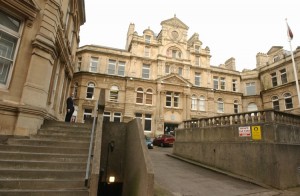This is a review sent to me by Stephen Kay, in which he discusses televised architecture in general and Ian Nairn in particular.
Cardiff City Council wants to demolish the Coal Exchange. Recently sound enough for the Fire Officer to allow it to be used as the superbly historic and richly patinated venue for the audience to gather at the end of National Theatre Wales’ performance odyssey around Bute Town, it has now become so dangerous as to require demolition. What would Ian Nairn have said of this proposed act of civic vandalism?
Mention of Ian Nairn no longer provokes the question of who he is, or was. An article by David McKie in the Guardian saw Gillian Darley’s seminal volume “Villages of Vision” back in print. Darley and McKie have now collaborated on a book reviving Nairn; “Ian Nairn; Words in Place.” And on Thursday night a number of the usual suspects contributed to a BBC 4 programme “The Man Who Fought the Planners”. Drawing on Darley and McKie’s book, this programme certainly have included much of Nairn’s views and many outings on camera, but transcended architecture to look directly at a human life. His strengths and his ability to fuel ways of looking at townscape, to shamelessly judge and compare elements of the vernacular, the traditional, the modern, and the utterly valueless were as honestly pictured as his sad decline into an extended alcoholic. Hagiography or academic analysis it was not, profoundly moving human drama it certainly was.
Nairn’s appearances were a surprise to anyone not having seen him before – it wasn’t Betjeman or Pevsner on screen. He had more in common with an actor displaying existential angst, a performer interpreting his reading of Jack Kerouac by driving a Morris Minor into a scrapyard. Former colleagues and fellow writers remembering him were one or two soloists, and sometimes a male chorus. Whilst Bill Patterson’s stately narration was offstage, Gillian Darley’s contribution was sustained, not only in a studio or library but at places Nairn had been filmed, period footage juxtaposed with today.
BBC 4 currently has a wealth of architecture, ranging from 1980s archive, through semi-hagiographies of “Brits That Built the World” to Jonathan Meades, whose programmes the BBC Media Centre announce as “lavish and sometimes surreal collage.” The archive BBC coverage of contemporary architecture had a budget that ran to commissioning music from Hans-Werner Henze, the semi-hags sink to supermarket or hotel lift music. The Darley/McKie book is published by Five Leaves Press, which raised the question of whether the programme would be accompanied by the music of Nick Drake. It wasn’t, but perhaps some of it should have been. From both men acute observation, both similarly idiosyncratic, sometimes elided delivery, and both great talent ended too soon. At the chime of a city clock Nairn may have delivered his opinion, the clock in many a bar slowly and sadly tolled his decline.
St

 @gilliandarley
@gilliandarley @gmdarley
@gmdarley Gillian Darley
Gillian Darley